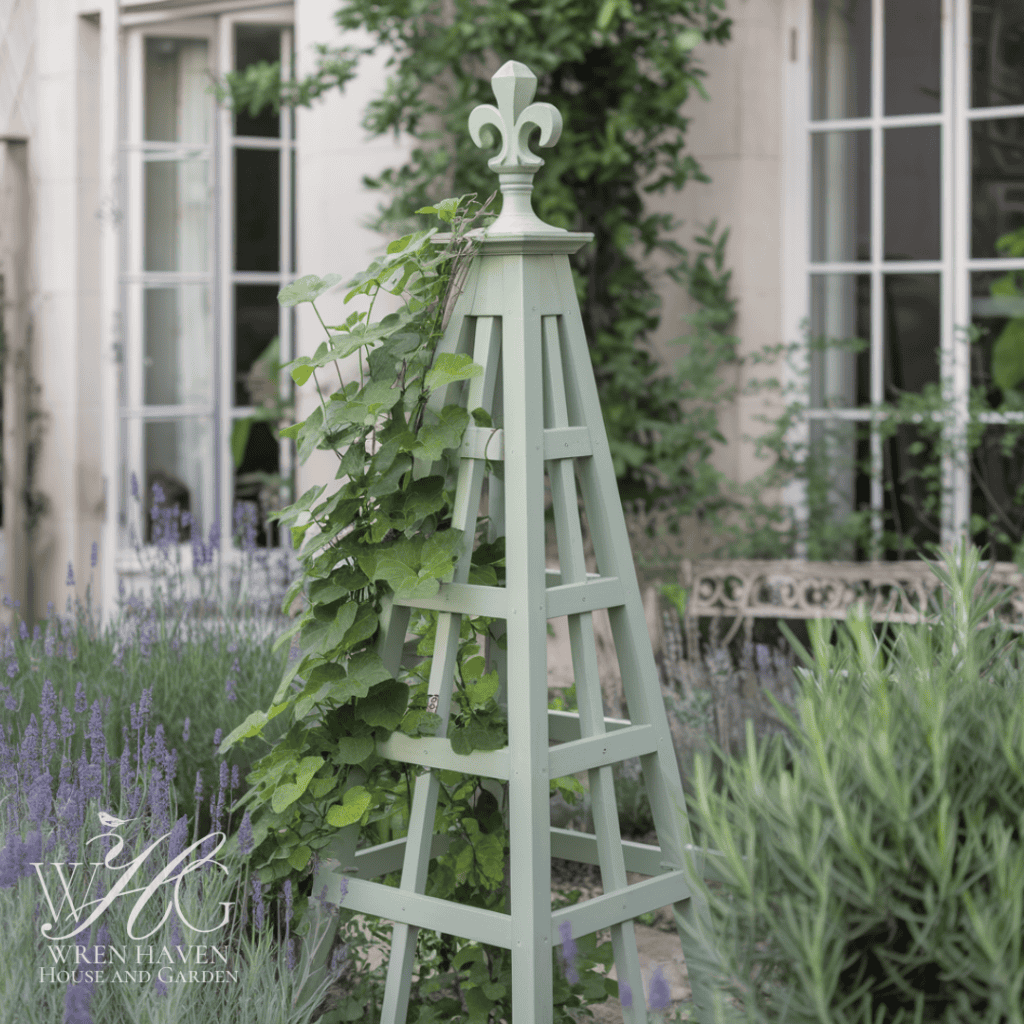The Cultural Significance of Tuteurs
Tuteurs have a rich history rooted in French garden traditions. They harken back to the formal gardens of the Renaissance, where symmetry, balance, and structure were prized. In those gardens, vertical elements like tuteurs and obelisks created focal points, drew the eye upward, and provided a framework for climbing plants to flourish.
Today, tuteurs remain a favorite in French country gardens, celebrated for their ability to marry simplicity with grandeur. They embody the French ethos of “l’art de vivre”—the art of living beautifully—by adding both utility and aesthetic charm to outdoor spaces.
A Note on Obelisks vs. Tuteurs
While both obelisks and tuteurs serve similar purposes in supporting climbing plants, they reflect different cultural traditions. Obelisks, more commonly found in English country gardens, often feature a straight, structured design that complements the formality of English landscapes. Tuteurs, on the other hand, are distinctly French, characterized by their softer, pyramid-like shapes and a flair for blending utility with artistic charm. Choosing between the two allows gardeners to infuse their space with the stylistic nuances of either English or French garden design.
Materials to Match Your Style
Tuteurs are available in a variety of materials, each lending its own character to your garden:
- Wood: Classic and rustic, wooden tuteurs blend seamlessly into natural surroundings. They can be painted, stained, or left to weather for a more organic look.
- Polymer or Composite Materials: Durable and low-maintenance, these modern options mimic the look of wood without the upkeep.
- Metal: Sleek and timeless, metal tuteurs are ideal for a polished look. Wrought iron or steel works well in formal settings.
- Copper: A luxurious choice, copper tuteurs develop a beautiful patina over time, adding depth and warmth to your garden.

Whichever material you choose, look for a design with an interesting finial to enhance the tuteur’s architectural appeal. A Fleur-de-lis finial lends an extra French flourish.
DIY Tuteurs: A Personal Touch
For a truly unique addition to your garden, consider making your own tuteur. With just a few materials and some creative flair, you can craft a piece that perfectly complements your garden’s style. Not only is it a rewarding project, but it also allows you to tailor the design, size, and finish to your liking.
If you’re intrigued, stay tuned for our step-by-step DIY Tuteur Tutorial, which will guide you through the process with ease. (Link to be added.)
Using Tuteurs in Your Garden
Incorporating tuteurs into your garden is both practical and decorative, and there are many ways to utilize them. Here are some ideas:
As a Focal Point
Placing a single tuteur in the center of a flower bed draws the eye and creates height. It becomes a centerpiece when paired with vibrant climbers like clematis or climbing roses.
To Frame an Entrance
Instead of an arbor, flank your garden’s entrance with two matching tuteurs for a stately and symmetrical look. When covered in fragrant blooms they’ll create an enchanting gateway that invites visitors in to explore your garden.
For Layered Height
Scatter tuteurs of varying heights throughout your garden to add dimension. Layering low plants, shrubs, and tall tuteurs creates a dynamic, visually engaging landscape.
Indoors or in Planters
Smaller tuteurs can be placed in planters to support climbing plants like jasmine or sweet peas. They are a beautiful way to bring height to patios, balconies, or even indoors displays. A miniature Tuteur is perfect way to train potted ivy on for some indoor greenery during the winter months.
With Nighttime Drama
Highlight your tuteurs after dark with soft uplighting or even some fairy lights. A small halogen or LED spotlight at the base creates stunning shadows and extends your garden’s beauty into the evening. And tiny fairylights wound around a tall tuteur are another way to lend a magical glow to the garden in the evening. Imagine softly sparkling pyramids of light set deep into your herbaceous borders, illuminating the walkways and casting a soft glow into the evening.
Why Every Garden Needs a Tuteur
Beyond their practical use as plant supports, tuteurs add texture, depth, and a touch of French elegance to your garden. Whether you choose a pre-made tuteur or craft one yourself, these timeless structures are a delightful way to add architectural interest and elevate your outdoor space.
So, the next time you’re visiting a garden center or wandering through a flea market, keep an eye out for a tuteur that speaks to you. Even if you’re not sure where to place it yet, bring it home—you’ll find the perfect spot for it soon enough to add a touch of French inspiration to your garden.